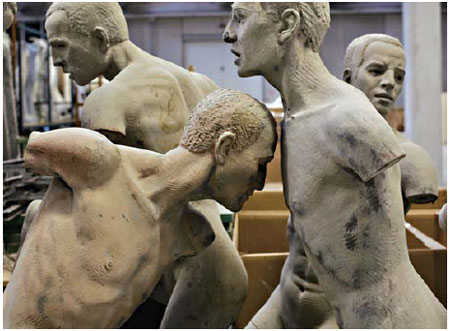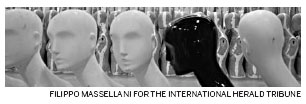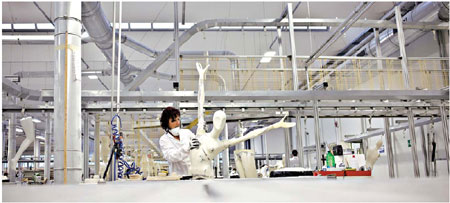Society
A real statement made by faux fashion models
Updated: 2011-03-06 07:43
By Elisabetta Povoledo (New York Times)
|
Mannequins manufactured by the Bonaveri factory in Italy are highly regarded by fashion designers like Armani, Versace and Ferre. Photographs by Filippo Massellani for The International Herald Tribune |


Renazzo Di Cento, Italy
To the untrained eye, the clusters of synthetic body parts scattered on the floor of a vast warehouse in Italy's heartland looked very much like - well, like clusters of synthetic body parts.
But to an expert like Andrea Bonaveri, whose family company has been making mannequins for 60 years, each slick torso, each sculpturesque limb, has its own story.
"These are waiting to be delivered to Burberry," he said, pointing to one bunch of white bodies. "Those legs are for Emilio Pucci. The somewhat prune-colored ones are for Louis Vuitton, and those gray ones are for Hugo Boss."
In the world of mannequin makers, Bonaveri is among a handful of companies whose brands are as recognizable as the fashion designers whose styles their models show off.
Bonaveri is "among the names that have their own value," said Luca Ceresa, the owner of Il Centro Pier, a Milanese showroom that represents Adel Rootstein, another mannequin maker. "To use a paragon that may be better understood, they are the Ferraris of the mannequin world."
Like Ferraris, Bonaveri mannequins are all about exclusivity and flash. They also have to communicate a subtle message that will lure customers into a shop.
The first objective of any shop window display "is not to sell but to declare the identity and the essence of the store or brand in terms of its positioning on the market and what it has to offer. To say, 'Here I am,'�? said Karin Zaghi, who teaches at Bocconi University's school of management in Milan.
"If a mannequin merely shows off clothes, it is functional," Ms. Zaghi said. "If it attracts the attention of a passerby, if it has the ability to communicate, then it is optimal."
And like Ferraris - built at a factory 48 kilometers away - Bonaveri mannequins do not come cheap. A complete Bonaveri mannequin costs 1,300 to 1,600 euros and up, or about $1,800 to $2,200, at retail.
Chinese imports now emerging on the European market can sell for less than 100 euros. But Bonaveri has managed to find its market.
What makes Bonaveri mannequins so costly is the degree of specialization. The company makes a gamut of models, using various materials, including polystyrene, leather and wood. The factory turns out 1,500 to 2,000 mannequins a month.
"We are constantly researching, even though the human figure is what it is," Mr. Bonaveri said.
Recently, the company has returned to fabric-covered models, which are painstakingly hand-sewn outside Cento, Italy.
"Each model has a history, a concept, a way of interpreting the clothing it exhibits," Mr. Bonaveri said. The first machines came when he began to use plastic in the 1960s, and significant expansion went hand in hand with the boom in ready-to-wear fashion and the emergence on the high-end market of designers like Giorgio Armani, Gianni Versace and Gianfranco Ferre.
Demand became such that the company could barely keep up with orders, said Mr. Bonaveri, who now runs the company with his brother Guido, who designs new models using laser scanners to replicate human figures. The technique is used alongside the traditional sculpture approach.
To increase production, the company built a larger factory five years ago outside Cento. Profit jumped 32 percent the first year it was operational.
Fashion houses are not the only clients. Department stores are big buyers - including Saks, Bloomingdales and Macy's, which is the biggest customer in the United States - as are museums, among them the Metropolitan Museum of Art in New York.
Bonaveri and other European manufacturers have opened factories in China to make cheaper lines, and China-based manufacturers are also on the rise.
Marketing experts suggest that, as a sales aid, mannequins are unlikely to go out of style.
"Brands may spend money on advertising and public relations, but sales points are becoming an increasingly important marketing tool," said Ms. Zaghi. "That's where brands take on life, and the context where everything must communicate that brand. It is the place where the final decision, to purchase or not, is made."
The New York Times
E-paper

Sindberg leaves lasting legacy
China commemorates Danish hero's courage during Nanjing Massacres.
Crystal Clear
No more tears
Road to the Oscars
Specials

NPC & CPPCC sessions
Lawmakers and political advisers gather in Beijing to discuss major issues.

Sentimental journey
Prince William and Kate Middleton returned to the place where they met and fell in love.

Rent your own island
Zhejiang Province charts plans to lease coastal islands for private investments

